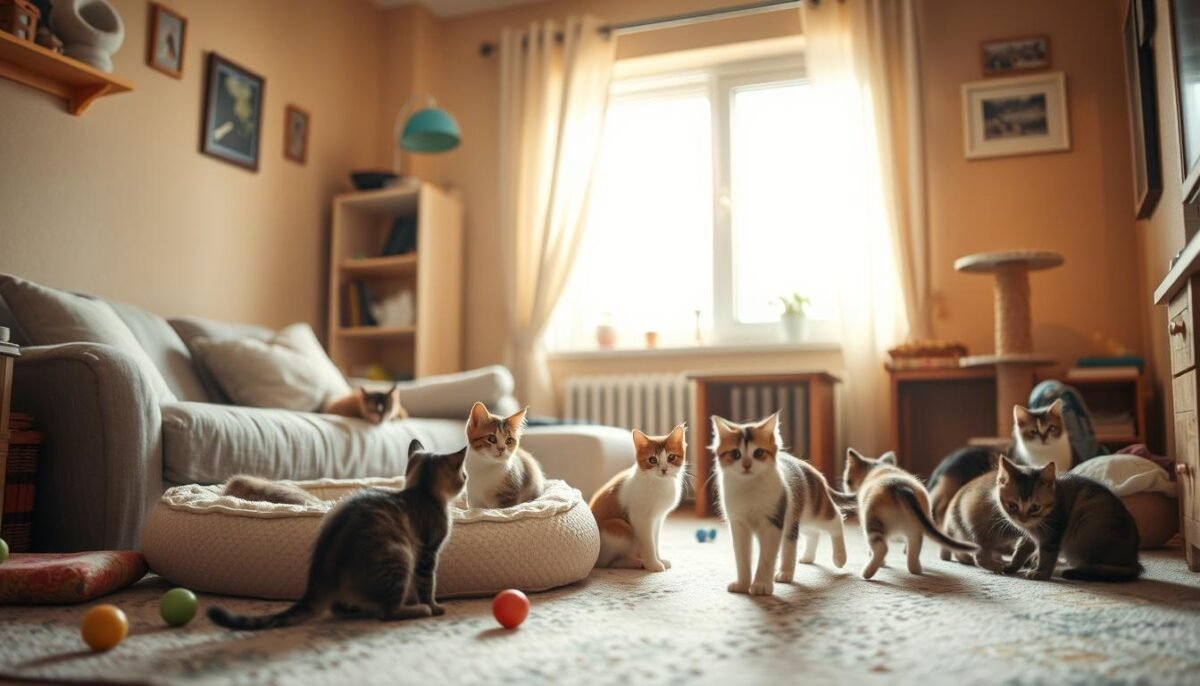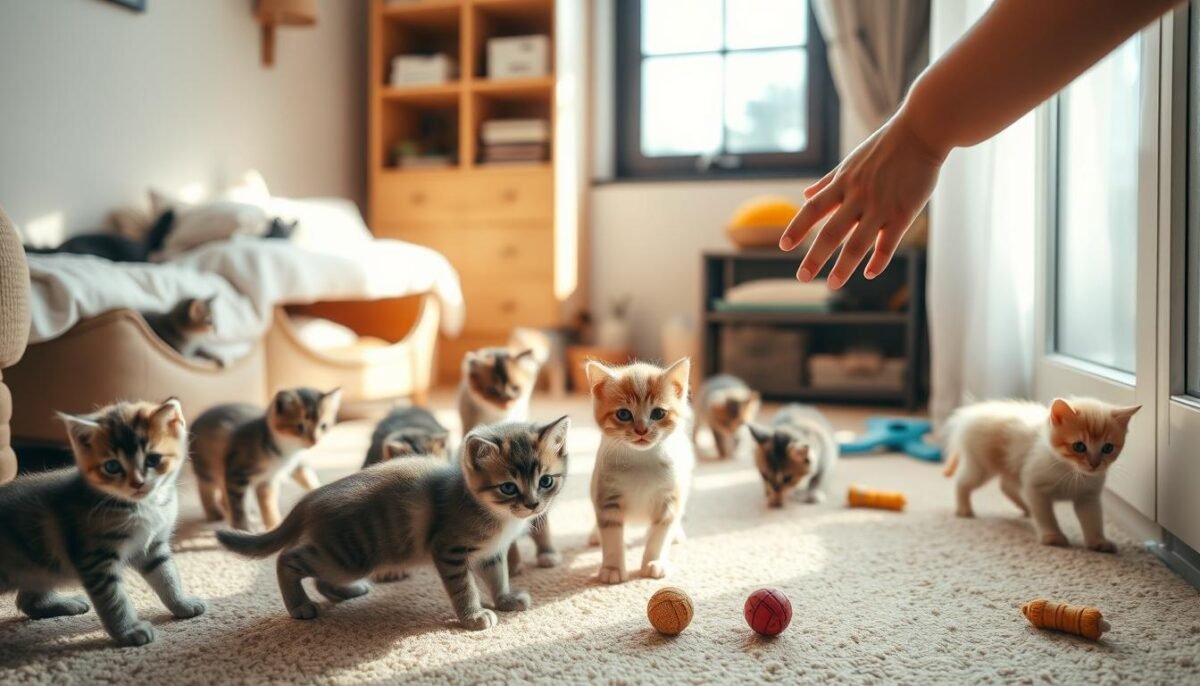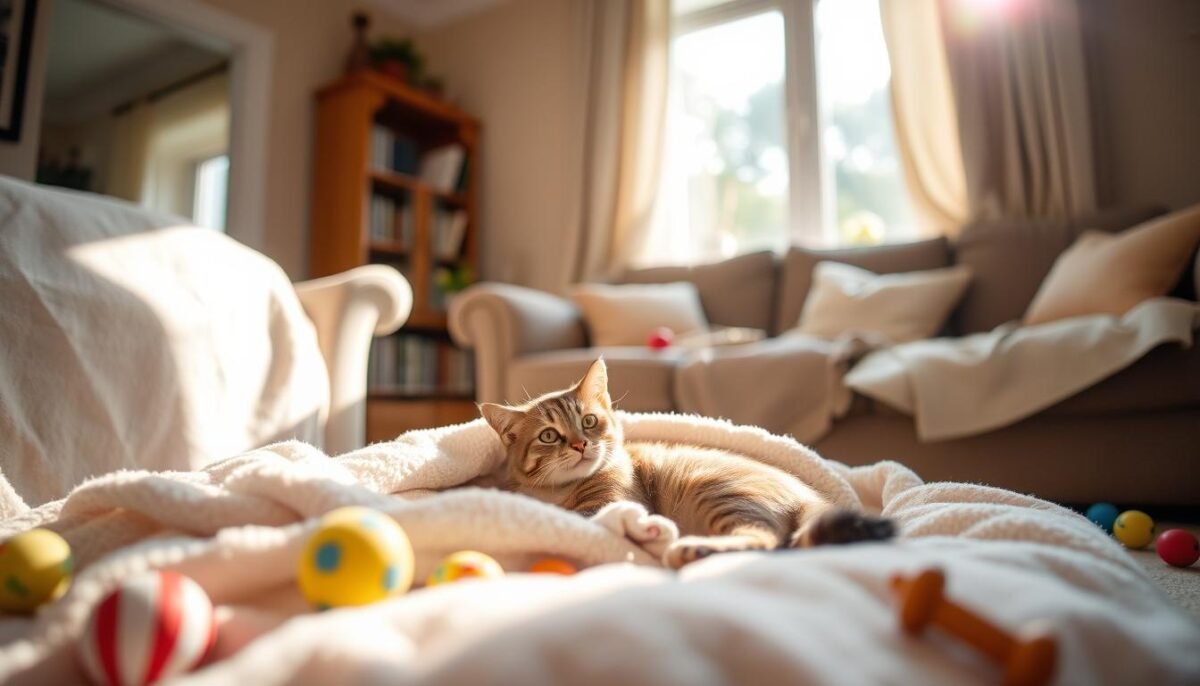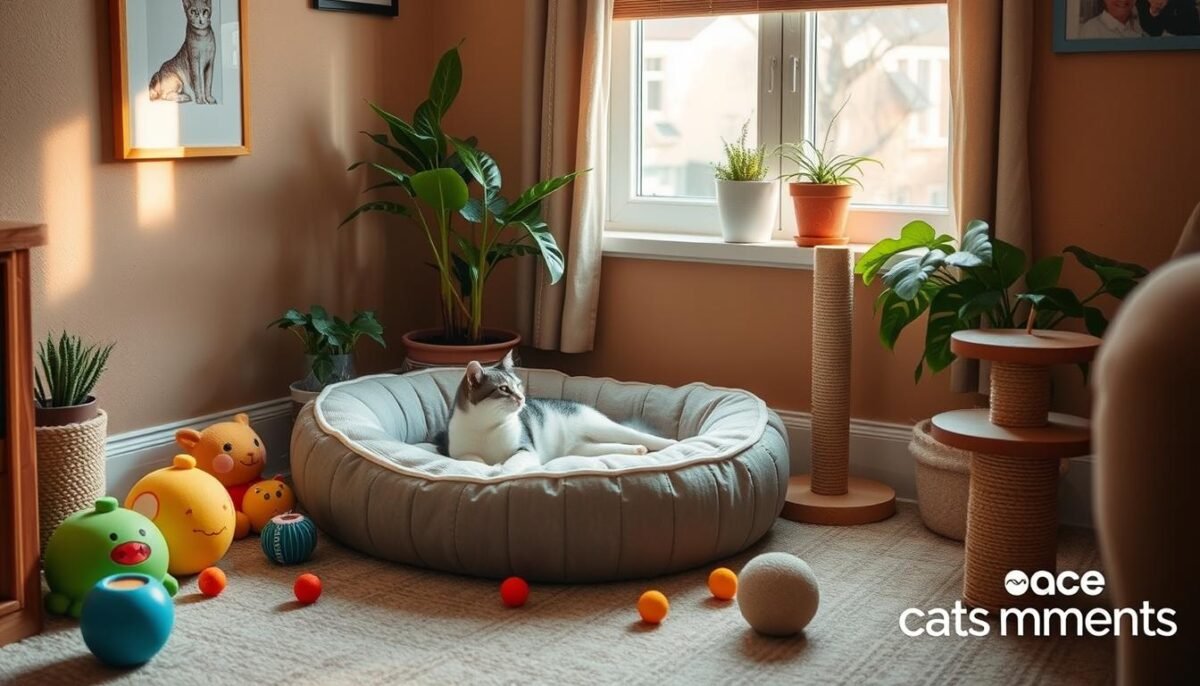Thinking about getting a cat? Adopting a cat is a big decision, filled with joy and responsibility. Have you thought about fostering a cat first? This guide will show you the benefits of fostering and how it can help you choose the right cat for your home.
Key Takeaways
- Fostering lets you care for cats temporarily without the long-term commitment of adoption.
- It gives you experience caring for cats and helps you decide if you’re ready for a permanent pet.
- Fostering also helps shelters care for more animals and improves adoption experiences.
- Check if your home, family, and schedule can handle fostering before making a decision.
- Fostering and adopting are different in terms of responsibilities, emotional bonds, and the transition process.
Thinking about welcoming a cat into your life? The question is: Should you foster before adopting a cat? Let’s explore the benefits of fostering and how it can help you make the best choice for you and your future pet.
Understanding the Benefits of Fostering a Cat
Fostering a cat can be very rewarding for both the animal and the foster family. It allows us to provide temporary care and support. This can have a big impact on the lives of cats in need. Let’s look at the main benefits of fostering a feline friend.
Emotional Support for Cats in Need
Cats in shelters or rescue groups often feel stressed and anxious. By welcoming them into our homes, we offer a comforting space. Here, they can feel safe, loved, and cared for. This emotional support is key in helping them heal and get ready for their forever homes.
Gaining Experience with Cats
Fostering is a great way to learn about cat care. We can discover their unique behaviors, what they eat, and their health needs. This knowledge is very useful for those thinking about getting a pet or working in animal rescue.
Testing Compatibility with Different Breeds
Fostering lets us meet many cat breeds and personalities. This helps us figure out which type of cat fits our lifestyle and preferences. It’s especially helpful for those unsure about which breed to adopt from a rescue group.
| Benefit | Description |
|---|---|
| Emotional Support | Provides a comforting environment for cats in need, helping them recover and prepare for their forever homes. |
| Gaining Experience | Allows us to learn about cat care and behavior, which can be valuable for future pet ownership or working in animal rescue. |
| Breed Compatibility | Helps us identify the cat breed that best suits our lifestyle and preferences, guiding our adoption decision. |
By fostering a cat, we can make a big difference in their lives. We also gain valuable experiences that can shape our future as pet owners or animal advocates. The benefits of fostering cats are both rewarding and fulfilling.
What Fostering Entails
Fostering a cat can be very rewarding. It also comes with its own set of responsibilities. As temporary pet caregivers, we help provide a safe and loving home for cats in need.
Daily Care and Responsibilities
Fostering a cat means giving it a lot of attention every day. We take care of its basic needs like feeding and cleaning the litter. We also make sure it gets regular playtime and grooming.
Costs Associated with Fostering
- Food and treats
- Litter and litter boxes
- Toys and scratching posts
- Veterinary care, including any necessary medical treatments or preventive care
- Supplies such as bowls, beds, and grooming tools
While the rescue organization often covers big expenses, we might face some extra costs. It’s key to talk about these costs before we start fostering.
Time Commitment and Flexibility
Fostering a cat takes a lot of time. We need to be ready to give the cat the care and attention it needs. The time we spend can change based on the cat’s needs and how long it stays with us. Rescue organizations help us find the right fit and support us while we foster.

Knowing what fostering involves helps us decide if it’s right for us. It’s about understanding the daily tasks, costs, and time needed for cat fostering. This way, we can see if temporary pet care or fostering to adopt cats fits our lifestyle and abilities.
How Fostering Helps Shelters
Fostering cats is great for the animals and helps local animal rescue organizations. It gives them a break from overcrowding. This leads to better chances for cats to find homes.
Increasing Space for More Animals
When cats go to foster homes, shelters have more room. This means they can help more animals. More cats get a chance to find their forever homes.
Reducing Stress for Shelter Cats
Shelters can be stressful for cats. Foster homes are more comfortable. This helps cats stay healthy and increases their adoption chances.
Promoting Adoption Through Positive Experiences
Cats in foster care show their true selves. This lets potential adopters see their personality. It leads to better matches and happy homes.

| Benefit | Impact |
|---|---|
| Increased Shelter Capacity | More animals can be accepted and cared for |
| Reduced Stress for Cats | Improved health and well-being of shelter cats |
| Positive Adoption Experiences | Better matches between cats and their forever homes |
Fostering cats helps them and supports animal rescue organizations. It’s a way to make a big difference. We help many cats and improve the pet adoption process.
Signs You Might Be Ready to Foster
Thinking about fostering a cat can be thrilling and fulfilling. But, it’s key to make sure you’re ready for the commitment. Here are some signs that show you might be ready to foster a cat in need.
Assessing Your Living Space
First, check if your home is ready for a foster cat. Do you have a special room for the cat? Is your home safe from dangers like open windows or loose wires? A safe and cozy spot is vital for your foster pet’s happiness.
Considering Family Dynamics
Living with family or roommates means considering how a foster cat will fit in. Will everyone in your home support and help with the cat? Fostering a cat is a team effort, so it’s important to have everyone’s support.
Evaluating Your Time Availability
- Can you give the daily care and attention a foster cat needs, like feeding and playtime?
- Are you ready to take the cat to vet visits or adoption events?
- Can you adjust your schedule to meet the cat’s needs?
Fostering a cat takes a lot of time. Think about how it will affect your daily life.
By checking your living space, family, and schedule, you can decide if fostering is for you. Remember, the cat’s happiness is most important. Being honest about your readiness is crucial for a good fostering experience.
Differences Between Fostering and Adopting
When it comes to caring for pets, there’s a big difference between fostering and adopting. Both involve giving a loving home, but the commitment and responsibilities differ a lot.
Temporary Care vs. Permanent Home
Fostering a cat is a short-term deal. We open our homes to care for a cat until a permanent home is found. This helps us provide temporary pet care and support shelters or rescue groups. Adopting, however, means giving a permanent home and caring for the pet for life.
Responsibilities and Expectations
- Fostering needs flexibility and the ability to say goodbye when the cat is adopted. Adopting, however, comes with long-term duties like vet visits, grooming, and financial costs.
- Fostering is rewarding for those who want to foster to adopt cats and gain experience. Yet, it also brings the emotional challenge of letting go.
Emotional Attachments and Challenges
Fostering is very fulfilling but requires us to be aware of emotional bonds. We may form strong connections with our foster cats. Yet, we must be ready to let them go to their forever home when needed. Adopting, however, lets us create a lifelong bond with our cat.
| Fostering | Adopting |
|---|---|
| Temporary care | Permanent home |
| Flexible responsibilities | Long-term commitments |
| Emotional detachment | Lifelong bond |
It’s key to know the differences between fostering and adopting when thinking about adding a new cat to our lives. By looking at the pros and cons of each, we can choose what’s best for us and our circumstances.

Preparing Your Home for a Foster Cat
Welcoming a foster cat is exciting and rewarding. But, your home must be ready for them. By making your space safe and comfy, you help your foster cat adjust well. This sets the stage for a great fostering experience.
Creating a Safe Environment
When a foster cat comes, safety is key. Start by making your home cat-proof. Secure electrical cords, houseplants, and small items that could be a choking hazard. Make sure windows and doors are safe with screens or locks.
Also, pick a room or area just for the cat. This lets them get used to their new home at their own speed.
Gathering Necessary Supplies
- Food and water bowls
- High-quality cat food (provided by the shelter)
- Litter box and litter
- Scratching posts or pads
- Toys and interactive playthings
- Comfortable bedding and hiding spots
- Grooming tools (brush, nail clippers, etc.)
Introducing the Cat to Your Space
When the foster cat arrives, introduce them slowly. Set up a room with everything they need. Let them get used to this space before showing them the rest of your home.
Keep their first area quiet and peaceful. Let them have space and time to adjust. Use treats and gentle touch to build trust and comfort.

By getting your home ready and following these steps, you can have a great fostering experience. Fostering cats helps animals in need and can lead to finding a new family member.
Transitioning from Foster to Adopt
Fostering a cat can be very rewarding. For many, it leads to adopting their cat permanently. Knowing when it’s a good match, talking to the shelter, and understanding the adoption process are key steps.
Recognizing Signs of a Good Match
While fostering, notice how you and the cat connect. If you look forward to their visits and the cat seems happy and comfortable, it might be a sign. Also, see how the cat gets along with your family and other pets. A good relationship is a strong sign of a successful adoption.
Discussing Adoption with the Shelter
If you decide to adopt the cat, talk to the shelter. They’ll guide you through the paperwork, fees, and timeline. They can also share insights about the cat’s personality and needs, helping the transition.
Preparing for the Adoption Process
- Make sure your home is ready for your new pet, with all the necessary supplies and a safe space.
- Check the shelter’s policies, like vet visits, microchipping, or behavioral assessments.
- Be ready to fill out adoption paperwork and possibly attend an event or interview.
Going from foster to adopt is exciting and fulfilling for both you and the cat. By recognizing a good match, talking to the shelter, and preparing for adoption, you can ensure a smooth transition to your new home.
| Fostering | Adopting |
|---|---|
| Temporary care for a cat in need | Providing a permanent home for a cat |
| Helps shelters by freeing up space and reducing stress for cats | Gives a cat a loving, forever home |
| Allows you to assess compatibility and readiness for pet ownership | Requires a long-term commitment to the cat’s wellbeing |
| Emotional attachment, but the cat eventually returns to the shelter | Deep, lifelong bond and responsibility for the cat’s care |
Common Misconceptions about Fostering
Fostering cats can be very rewarding, but there are myths that might stop people from trying. Let’s clear up some of these myths and show what fostering really means.
Fostering Takes Too Much Time
Many think fostering a cat takes a lot of time. While it does add some extra work, it’s not too much. Shelters and rescue groups offer training and support to help you fit fostering into your life. With a little planning, fostering can be a great experience without taking over your schedule.
You’ll Get Too Attached
Some worry they’ll get too attached to the foster cat. It’s true, you’ll bond with them, but fostering is a chance to help without adopting long-term. Shelters and rescue groups help you deal with these feelings and find the right homes for the cats.
Fostering is Only for Experienced Owners
Many think fostering is for only those who have owned cats before. But, this isn’t true. Shelters and rescue groups offer training to help anyone foster, whether you’re new to cats or not. Fostering is open to everyone, and it can be a very rewarding experience.
By understanding and debunking these myths, we can encourage more people to foster cats. Fostering is not just about helping cats; it’s also about personal growth and feeling fulfilled.
Conclusion: Making the Decision to Foster or Adopt
The choice between fostering a cat or adopting one is big. Both paths have their own benefits and duties. Your decision should match your life and what you prefer.
Fostering is great if you’re not sure about adopting long-term. It lets you care for a cat temporarily. This way, you can see if you’re ready for a permanent pet. If you’re ready for a lifelong friend, adopting a cat can be very rewarding.
It’s key to think about your lifestyle and what you can offer. By fostering or adopting, you help cats in need. You also get to enjoy their company, making your life better.
FAQ
What are the benefits of fostering a cat before adopting?
Fostering a cat before adopting has many benefits. It offers emotional support to cats in need. It also gives you a chance to learn about cat care and see if you’re compatible with different breeds. This way, you can understand the responsibilities of pet ownership before committing long-term.
What are the daily responsibilities and costs associated with fostering a cat?
Fostering a cat means daily care like feeding and grooming. It also means providing a safe, loving home. The costs, like food and vet care, are usually covered by the rescue organization. While it requires some time, the support from the organization makes it easier.
How does fostering a cat benefit animal shelters?
Fostering cats helps shelters in many ways. It increases their capacity to take in more animals. It also reduces stress for the cats and helps them get adopted. Foster families are key in preparing cats for their new homes, improving their adoption chances.
What are the signs that I might be ready to foster a cat?
To know if you’re ready to foster a cat, think about your living space and family. Consider if you can provide a safe, nurturing home and if you’re flexible enough. The rescue organization can help you decide if you’re ready.
How does fostering differ from adopting a cat?
Fostering and adopting a cat differ in commitment. Fostering is temporary, while adopting is permanent. Fostering lets you experience pet ownership without long-term responsibilities. However, it can be emotionally challenging when the cat is adopted.
What are some common misconceptions about fostering cats?
Some think fostering cats takes too much time or that you’ll get too attached. Others believe it’s only for experienced owners. But fostering can be flexible, and support from rescue organizations helps manage attachment. It’s a great way for new owners to gain experience before adopting.






